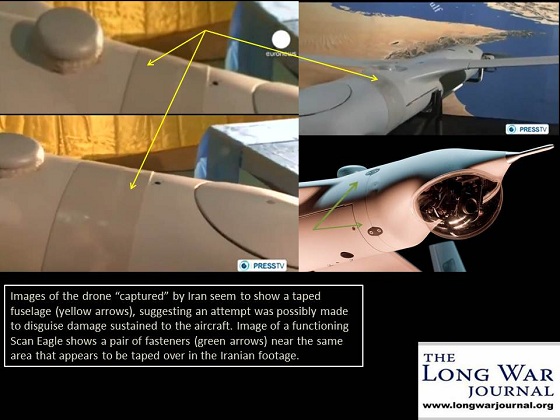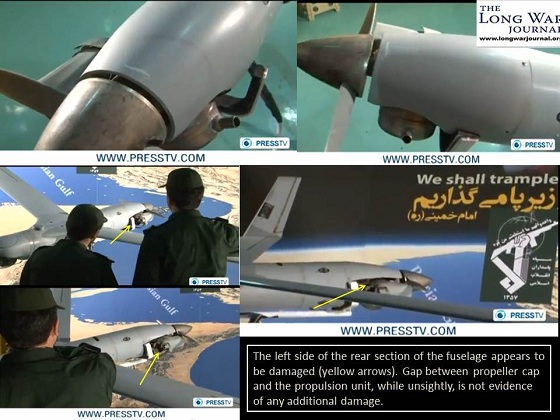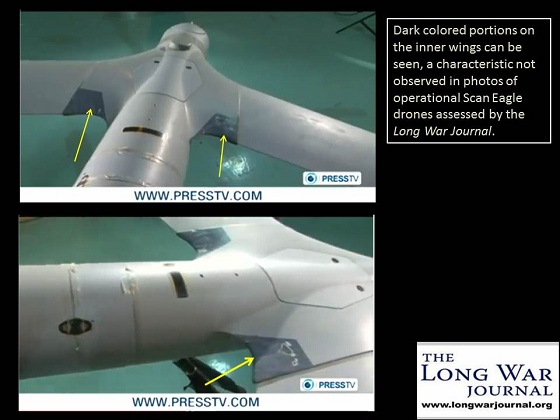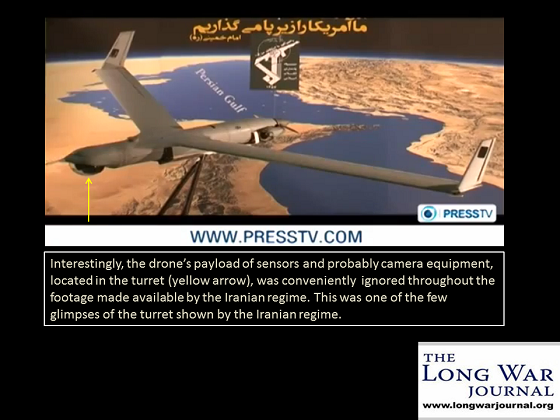Earlier this week, Iran announced that it had “captured an American unnamed aircraft,” and released a short video clip showing Iranian military officials inspecting what appears to be a US-manufactured Scan Eagle drone. Iranian officials were quick to claim that elements of the Revolutionary Guards’ Navy captured an American Scan Eagle drone after it entered Iranian airspace somewhere near the Persian Gulf island of Kharg, which is located about 300 miles northwest of the Strait of Hormuz and 16 miles off the Iranian coast. US officials swiftly denied the claim, and a spokesman for the Navy’s Bahrain-based 5th Fleet said all US drones in the region had been “fully accounted for.”
Interestingly, Kharg Island is administered by the Iranian province of Bushehr, which is also the location of Iran’s controversial Russian-built nuclear reactors. Kharg Island has also been the scene of recent alleged violations of Iranian airspace by US drones, according to Iranian military officials. Iranian warplanes even fired missiles at a US drone — but missed hitting it — near Kharg Island on Nov. 1.
Iran’s Scan Eagle video images
While the video clip certainly shows what appears to be a Scan Eagle drone built by the Boeing subsidiary Insitu, there are several curiosities that bear mentioning. Although the condition of the drone seems to be intact, there appear to be several suspect areas that might be showing signs of damage, although it cannot be determined how or when this damage might have occurred. Additionally, what appears to be a two or three-inch-wide strip of tape can be seen sealing the fuselage to the nose — whether this was done prior to the drone’s last flight by its owners or by the Iranians to disguise the seam, for whatever reasons, remains unknown.


There are also two darker-colored portions located on the inner side of the wings near the fuselage, which seem unique compared to various photos of operational Scan Eagle drones assessed by The Long War Journal.

The Scan Eagle is a relatively inexpensive drone that has been in service since 2004 and is known to be used by the US Navy, the Marine Corps, and many others, including the armed forces of Australia and Canada. The drone evolved out of an earlier Insitu drone platform, the Sea Scan, which had been designed to help international commercial entities track weather patterns and assist fishermen locate schools of fish. Most of the sensitive equipment is located in the turret, a bubble mounted on the nose of the drone, which was interestingly omitted from most of the video footage provided by the Iranian regime.

What makes the $3 million Scan Eagle drone unique is its ability to be launched from a pneumatic launcher, which is advantageous since the drone can be deployed from a vessel and does not require an airfield or runway for takeoff. That said, the pneumatic launcher is relatively easy to transport and can be used to launch the drone from land as well. The origin and ownership of the drone shown by the Iranian regime remain unknown, especially since the aircraft was devoid of any characteristic markings or symbols. Because this type of drone is widely used by foreign militaries, and possibly also by commercial entities, Iran’s possession of a “captured” Scan Eagle drone does not necessarily mean that it was a US military-operated drone.
Previously, Iran claimed to have captured an advanced Lockheed Martin RQ-170 reconnaissance drone, in December 2011. American officials later conceded that an RQ-170 had lost contact with its controllers somewhere over western Afghanistan. Video images of the captured drone were quickly produced, like those of the Scan Eagle, and raised a series of questions over Iran’s claims that it had “spoofed” the communications relay of the RQ-170 and safely guided the aircraft down to an undisclosed Iranian airfield. In that video, the underbelly of the aircraft remained covered and the wings appeared to have been reattached, suggesting that the Iranians had located a downed RQ-170 that most likely crashed inside Iranian territory.
Are you a dedicated reader of FDD's Long War Journal? Has our research benefitted you or your team over the years? Support our independent reporting and analysis today by considering a one-time or monthly donation. Thanks for reading! You can make a tax-deductible donation here.








3 Comments
It could easily be a CIA drone, since im sure the CIA will never issue information of whether its drones have been accounted for or not.
Personally, I believe the Iranian’s as far as I can pee. They lie about everything, all the time. So this could easily be BS:)
The tape would appear to offer some prospect of reducing the radar signature. The conventional closures reflect back like hand mirrors.
The utter lack of any ownership insignia would typify a spy agency.
Israel has been caught, time and again, using false flag operations against Iran. These have been mostly kept out of the media spotlight.
It would be pretty illogical for the USN to operate this particular unit in that area. So the official denials of a lost machine make sense.
It would be very logical for the Israelis to operate a platform that is as common as Chicklets. Deniability would be a high priority.
It would’ve been tasked with obtaining the natural commercial routines of the area.
The darkness at the rear wing-roots is likely to be a radar absorbent application. That spot is a typically reflective hot-spot — particularly for pursuing radar equipped aircraft.
Very close inspection will show that the Iranians have removed yet another radar absorbent band that used to cover the rear-area fasteners. Note the ragged paint zone.
The damage back towards the motor probably occurred when, for whatever reason, its stealthy covering was disturbed.
Such slow fuzzy targets are neigh impossible for jet fighters to bring down. They’re just too far out of their flight envelope.
They are, however, vulnerable to 1930s era biplanes. So it wouldn’t surprise me to find out that the Iranians have used crop dusters, or some such, as a counter-drone platform.
This particular drone could’ve been launched from any number of clever platforms.
It is surprising that it did not self-destruct — like an Imperial Probe-Droid. Even Lucas figured that one out.
These drone captures are some indication that Iran has agents spilling the beans from deep inside the American defense establishment, software beans.
That might be reasonably be assumed to come by way of Red China — and its first rate black hats for hire.